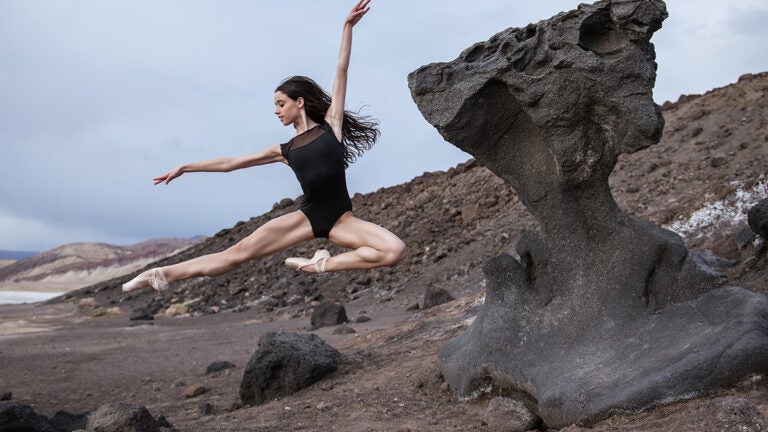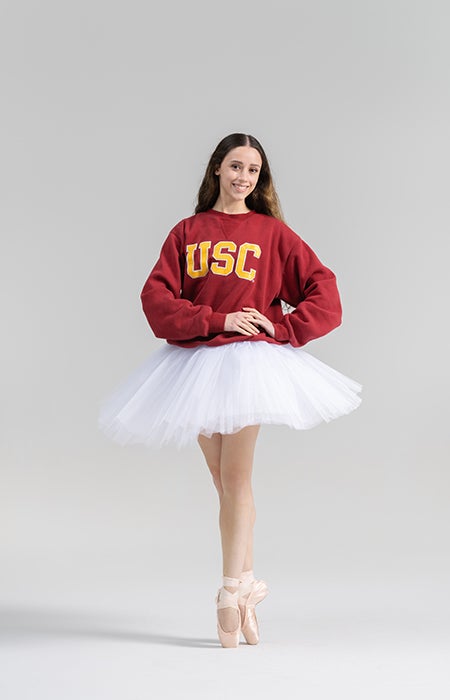
Shift to online learning allows student to balance biology studies with a ballet career
In April 2020, Gabriella Schultze had been a trainee with the Ballet West dance company in Salt Lake City for two years when she learned she was promoted to the next rank, just below the main company. But she had a hard decision to make: She had already deferred admission to USC Dornsife College of Letters, Arts and Sciences twice during her traineeship, so what should she do now?
When she found out that USC would be holding its fall 2020 courses online, the choice became considerably easier. Schultze decided she could continue to train for “Sleeping Beauty” by day and pursue her studies at night and on the weekends.
“I was excited to learn that the classes were virtual, so I could work that into my dance schedule. Because they were online, I was able to do them after the ballet classes,” says Schultze, a biological sciences major.
A born performer
Originally from Seattle, Schultze started ballet lessons at age 5. Her mom thought they would be a good way to work off some of her extra energy.
“At first I didn’t like it very much, but the first time I performed on stage around 7 or 8, everything completely changed, and I fell in love with performing,” she says.
After Schultze graduated high school, she moved to Salt Lake City to become a trainee with Ballet West. Deferring her enrollment to USC Dornsife twice, she spent the next two years dancing full time. In April 2020, she was promoted to Ballet West II, the next step along the path to joining the main company.
Schultze would like to see a more diverse ballet world, and she credits Ballet West Artistic Director Adam Sklute with being open to those conversations.
“My father is part Lebanese, and I am very aware of the fact that ballerinas of Middle Eastern descent are very underrepresented in the ballet world,” she says.
Working day and night
Although she loves dancing, Schultze says that she missed academics during her two years as a trainee. She was happy to enroll at USC Dornsife last fall to continue studying.

“I have a very active brain, so I love having something to come home to that is academic. It’s been great adding studying back into my life. I feel more balanced,” she says.
Schultze spent the fall in a COVID “bubble” with her fellow Ballet West II dancers, rehearsing and performing a few productions, including an excerpt from “Sleeping Beauty” that was recorded for area public schools.
Dancing from 10 a.m. until 6 p.m. every day and then switching to classes and homework challenged her, Schulze says. She notes that in order to avoid being too tired to dance, she had to schedule her time meticulously.
There were some conflicts, but she and her professors were able to work them out, and she ended up with an A average for the fall semester, she says.
“The hardest thing was when quizzes were scheduled for certain times of the day and they were only open for 12 hours or so. The professors were great; they were super accommodating of the situation, and so was Ballet West.”
Right now, Schultze is unsure how her life after college will proceed. She wants to continue dancing and hopes to be promoted to the main body of Ballet West, but she realizes a dancer’s career is relatively short, ending, at best, around age 40.
As for a possible science career, Schultze is especially interested in genetic research. “I think it’s phenomenal how much we’ve learned since the genome was sequenced just 20 years ago. I’d love to work in genetics.”
For now, Schultze will keep dancing, and she is eager for the day she can return to L.A. to come to campus.
“When I toured Dornsife during my visit and listened to the students talking about the wide variety of majors and minors, I was sold,” she said. “I felt that this was the place where my unusual background would be celebrated, and that it would allow me to develop both my passion for science and my love for dance.”